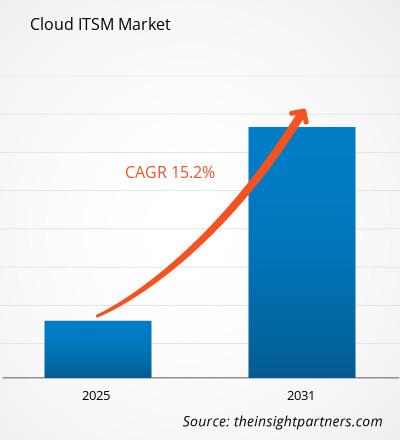页面已更新 :
Jan 2025
预计从 2025 年到 2031 年,云 ITSM 市场复合年增长率将达到 15.2%,市场规模将从 2024 年的 XX 百万美元扩大到 2031 年的 XX 百万美元。
该报告按组件(解决方案、服务)细分;组织规模(大型企业、中小企业);行业垂直领域(BFSI、IT 和电信、制造业、零售和消费品、政府和公共部门、其他)。全球分析进一步细分为区域和主要国家。该报告以美元为单位提供了上述分析和细分的价值。
报告目的
Insight Partners 发布的《云 ITSM 市场》报告旨在描述当前的格局和未来的增长、主要驱动因素、挑战和机遇。这将为各种商业利益相关者提供见解,例如:
- 技术提供商/制造商:了解不断变化的市场动态并了解潜在的增长机会,使他们能够做出明智的战略决策。
- 投资者:对市场增长率、市场财务预测和整个价值链中存在的机会进行全面的趋势分析。
- 监管机构:规范市场政策和警察活动,旨在最大限度地减少滥用,维护投资者的信任和信心,维护市场的完整性和稳定性。
云 ITSM 市场细分组件
- 解决方案
- 服务
组织规模
- 大型企业
- 中小企业
垂直行业
- 金融服务业
- IT 和电信
- 制造业
- 零售和消费品
- 政府和公共部门
- 其他
地理位置
- 北美
- 欧洲
- 亚太地区
- 南美和中美
- 中东和非洲
自定义此报告以满足您的要求
您将免费获得任何报告的定制,包括本报告的部分内容,或国家级分析、Excel 数据包,以及为初创企业和大学提供超值优惠和折扣
云 ITSM 市场: 战略洞察

- 获取本报告的主要市场趋势。这个免费样本将包括数据分析,从市场趋势到估计和预测。
云 ITSM 市场增长动力
- 云服务日益普及:云计算的日益普及是云 IT 服务管理 (ITSM) 市场的关键驱动力。企业正在将其 IT 运营迁移到云端,以获得更高的灵活性、可扩展性和成本效益。基于云的 ITSM 工具可简化服务交付、降低运营成本并改善整体 IT 管理,从而推动更多企业采用这些解决方案。
- 提升 IT 运营效率的需求:随着企业面临日益增长的 IT 复杂性,对更高效的 IT 服务管理解决方案的需求也日益增长。云 ITSM 平台提供自动化的工作流程、更快的响应时间和增强的协作,从而提高运营效率。这些解决方案使 IT 团队能够主动管理事件、减少停机时间并增强服务交付,使其成为现代商业环境中不可或缺的解决方案。
云 ITSM 市场未来趋势
- 向云原生 ITSM 解决方案迈进:为了满足现代业务需求,企业正在从传统的本地部署 ITSM 解决方案转向云原生解决方案。这带来了更好的可扩展性、远程可访问性和更灵活的服务交付模式。云原生 ITSM 解决方案支持动态按需运营,从而提高效率和响应能力。这是因为世界需要敏捷、可扩展的系统来适应业务需求的变化并支持分布式劳动力。
- 自助服务门户和知识管理:自助服务门户正在成为云 ITSM 中的一个重要趋势,它允许最终用户无需 IT 团队干预即可解决 IT 问题。集成的知识管理系统为用户提供常见问题解答、教程和故障排除指南。这一趋势减少了服务台数量,缩短了响应时间,并通过提供快速访问相关信息的方式提高了用户满意度。
云 ITSM 市场机遇
- 适用于混合 IT 环境的云 ITSM:随着企业采用混合 IT 环境,云 ITSM 供应商有越来越多的机会提供同时支持本地和云端 IT 服务的解决方案。混合云 ITSM 平台使企业能够无缝管理其多样化的 IT 环境,确保服务交付、事件管理和整体运营效率的一致性。
- 人工智能驱动的服务管理:随着人工智能和机器学习能力的发展,云 ITSM 提供商可以利用这一机会开发更先进的人工智能驱动的服务管理解决方案。人工智能可以预测潜在的服务中断,自动化工单路由,并提供解决事件的智能建议。通过利用人工智能,供应商可以增强 ITSM 平台的功能,并提供更主动的服务管理。
云 ITSM 市场
The Insight Partners 的分析师已详尽阐述了预测期内影响云 ITSM 市场的区域趋势和因素。本节还讨论了北美、欧洲、亚太地区、中东和非洲以及南美和中美洲的云 ITSM 市场细分和地域分布。
云 ITSM 市场报告范围
| 报告属性 | 细节 |
|---|---|
| 市场规模 2024 | US$ XX million |
| 市场规模 2031 | US$ XX Million |
| 全球复合年增长率 (2025 - 2031) | 15.2% |
| 历史数据 | 2021-2023 |
| 预测期 | 2025-2031 |
| 涵盖的领域 |
By 组件
|
| 覆盖地区和国家 | 北美
|
| 市场领导者和主要公司简介 |
|
云 ITSM 市场参与者密度:了解其对业务动态的影响
云 ITSM 市场正在快速增长,这得益于终端用户需求的不断增长,而这些需求又源于消费者偏好的不断变化、技术进步以及对产品优势的认知度不断提升等因素。随着需求的增长,企业正在扩展其产品线,不断创新以满足消费者需求,并抓住新兴趋势,从而进一步推动市场增长。

- 获取 云 ITSM 市场 主要参与者概述
主要卖点
- 全面覆盖:该报告全面涵盖了对云 ITSM 市场的产品、服务、类型和最终用户的分析,提供了整体格局。
- 专家分析:该报告基于对行业专家和分析师的深入了解而编写。
- 最新信息:该报告涵盖了最新信息和数据趋势,确保了业务相关性。
- 定制选项:此报告可以根据特定客户要求进行定制,并恰如其分地适应业务策略。
因此,有关云 ITSM 市场的研究报告可以帮助引领解码和理解行业情景和增长前景的线索。尽管可能存在一些合理的担忧,但本报告的总体优势往往大于劣势。
- 历史分析(2 年)、基准年、预测(7 年)及复合年增长率
- PEST和SWOT分析
- 市场规模、价值/数量 - 全球、区域、国家
- 行业和竞争格局
- Excel 数据集
近期报告
客户评价
购买理由
- 明智的决策
- 了解市场动态
- 竞争分析
- 客户洞察
- 市场预测
- 风险规避
- 战略规划
- 投资论证
- 识别新兴市场
- 优化营销策略
- 提升运营效率
- 顺应监管趋势
我们的客户































87-673-9708

ISO 9001:2015



 获取免费样品 - 云 ITSM 市场
获取免费样品 - 云 ITSM 市场